
PA3CLQ's Leuke Linken Nr. 449
A little Off Topic from Jeff K9JP
Greetings Group,
I was blessed to win an auction for a Viking Adventure transmitter.
Yes, it seems that vintage transmitters and a new passion for me.
I found the assembly and operator instruction manual for the transmitter online and have saved it as .pdf file.
So, what do I need to learn from you Experts
that have, or have used a Viking Adventurer?
Merry Christmas and Thanks for letting post this,
Jeff K9JP
REM :
Hi Jeff -
Take a look at Janis, AB2RA's page on her rebuild:
http://wireless-girl.com/Projects/AMTransmitters/JohnsonAdventurer/
She is a very smart woman and put some work into improving on a good design already.
I think that would be helpful to you.
I have one that was extensively modified and butchered up so, I have a lot of work ahead of me this spring to un-do a poor job on my Adventurer.
I think you will have fun with it as it is a good, basic CW transmitter.
73, Paul - K7IN
REM :
Also, to make sure " real radios glow in the dark", be sure and use a voltage regulator gaseous glow tube of the appropriate Voltage.
I use an 0B2 in my power supply for a
Grief-Kit HG-10 VFO.
Sam N5AF
Identify Straight Key
I have been using a straight key that I cannot identify anywhere.
Two pictures of this key are attached. ( only one here )
There are no markings of any kind on the key.
I am inclined to believe it is a one-of-a-kind home-made key by someone with a nice machine shop but, I'm not sure.
If this was a commercially made key or custom
made by a ham, I would be very interested in knowing it's origin.
This key came from the estate of a good friend and silent key, Bob Davis, K7IY.
It was in a box of miscellaneous items that I bought during his estate sale.
I use this key most of the time on the air and have come to like it much more than my other four straight keys.
Thanks ahead of time for your help!
73, Paul Cavnar - K7IN
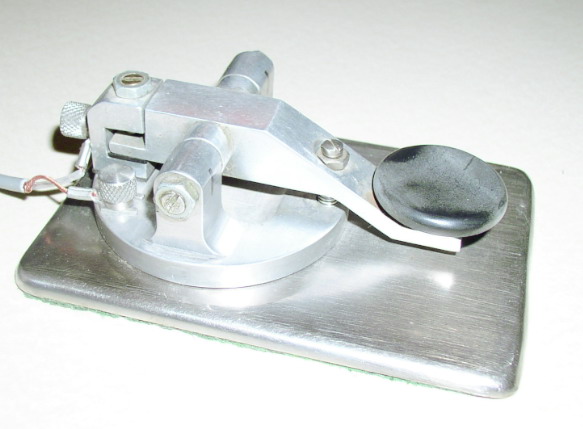
REM :
Paul,
I'm going to take a wild guess and say that the key is homemade -- well-made
for sure, by someone with machining skills.
Commercially made keys typically have some form of ID on them and aren't so, er, monochromatic.
If K7IY wasn't into machining, I wonder if he
acquired it from someone who was.
With best regards,
Pete WB5BUP
Anyone understand this key or can
explain the purpose for second lever?
Very interesting unique key and very talented UA3AO:
https://www.youtube.com/watch?v=kSwLK8QA8ys
73 es 77 de VK5EEE Lou.
REM :
Hello all,
Makes extra dashes with the forefinger from the left to the right.
73, Editor
REM :
The dashes are made with a motion like a sideswiper!
73, DR N1EA
REM :
Lou,It's the same idea as this key.
I couldn't see what he was doing!
This one he sends a bunch of numbers and I figured out why he was doing!
https://www.youtube.com/watch?v=9g6z7-d1fiI
What do you think about this kind of key?
The dashes are very well formed, that's why I like this key.
I wish I could buy one as I'm not a machinist.
73, David N1EA
REM :
WOW! I didn't understand until this video.
UA3AO does Russia proud !
I say this has to be one of the best Morse Keys ever.
I want one too.
Not saying a simple side swiper isn't UFB on its own, but UA3AO is the ultimate bug.
In Adelaide here used to be a bug that produced auto dahs, that
must be another special but almost extinct now.
77 de Lou5eee
REM :
The two fully automatic mechanical Australian keys were the Hitchcock AutoMorse and the Simplex Deluxe Auto, the latter is a right angle pendulum key. Hitchcock was from circa 1920 ] was used in Western Australia where wire Morse used American Morse with its types of dashes for T, L and 0 (zero).
Values of 3, 7 and 10 baud.
If you can get the man who makes keys (Herman) in Australia to make few I'll buy one!
It's the best key I have ever heard!
Listen to the quality and precision of the dashes.
Louis, I have a Hitchcock AutoMorse but I'm afraid the mainspring that the enormous weight is placed at the end of us bent at approximately 30 degree angle inwards, which seems to prevent the production of decent dashes, so the device is a curiosity for my apartment's visitors along with the Magnavert vertical bug made by W.R. (Bill) Smith, W4PAL (silent key) which produces streams of dashes by magnetic fields instead of various leaf and coiled steel compression springs like Vibroplex and even the Hitchcock use.
Do you or Doc know Georg from Sydney who makes Morse keys well enough to approach him about making a copy of the UA3AO cootie bug? http://www.morsekeys.com/
73, David N1EA
REM :

Hitchcock AutoMorse key on:
http://www.ebay.pl/itm/201702888479

Simplex Deluxe Auto
General information at:
http://www.morsemad.com/simplex.htm
SDA movi at:
https://www.youtube.com/watch?v=h2GcyEnevxw
Picture of SDA at
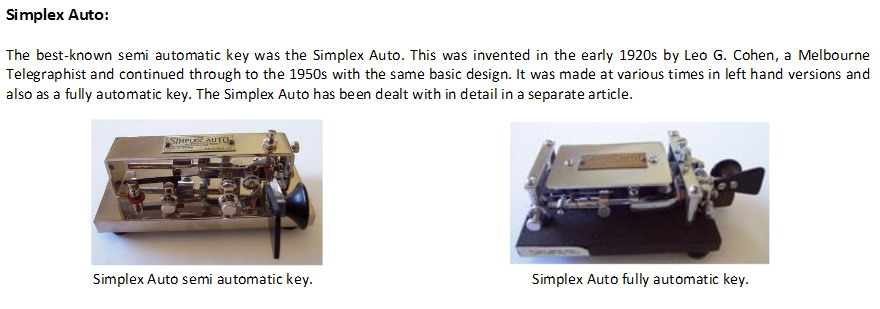
REM :
Recently with some electronics I transformed the dah from a
standard vibroplex (blue racer) to dah dah dah as long as pressed in dah
direction with the spacing and dahs automatic correct length derived from the
dits of the bug. But , true, it is electronics, not the wonderfull mechanical
designs that do it all mechanical.
As far as I understand it is a normal vibroplex and sequential dahs are made
the sideswiper way.
http://pa0wv.home.xs4all.nl/pdfbestanden/bugbutcher.pdf
Wim PA0WV
Polechanger Keys (Pole Changer Keys)
In looking at a picture of a Polechanger Key I could see four screw terminals, one switch wiper, and three contacts to which the wiper could connect.
Since the number of terminals matches the number of switch contacts I am having trouble imagining how the Key lever could change the polarity of the circuit.
Is that change made manually with the selector switch?
Tom Horne
REM :
The pole changer key is a double contact key…
The lever makes on either the forward or back contact.
The switch swaps the contact point connections to the output terminals.
So, if the circuit connection is made to the lever terminal, and pos and neg battery is connected to two of the other terminals, then the switch can select whether pos or neg battery is connected to the line on “ key down”.
The other or opposite polarity will.be connected when “key up” .
Ed FB Asst WC MTC
REM :
My answer was unclear…
The switch either allows the key lever to change polarity output on the lever terminal, or not, depending on the position of the switch.
IIRC, the switch selects the polarity of the front contact with respect to that of the back contact.
Switch lever positioned to the left connects the SAME polarity to both the front and back key contacts so that operating the key does not result in polechanging output.
Switch lever positioned to the right allows the key lever to output one polarity key up, opposite polarity key down.
I think.
I no longer have one of these keys to physically look at.
Great question.
Perhaps Mr. Hausler can assist in answering this inquiry. Ed. FB
Tom Horne
REM :
There are special keys for transferring morse code via long submarine cables with a high capacitance values.
To prevent charging the cable is the following next morse code character with a reversed polarity.
Below Polechanger keys from
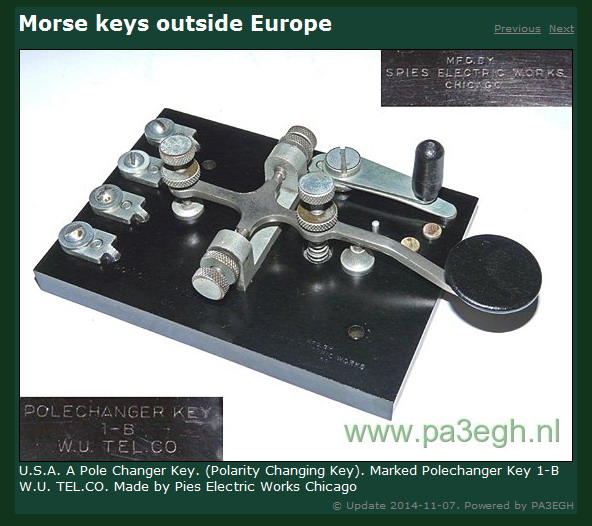
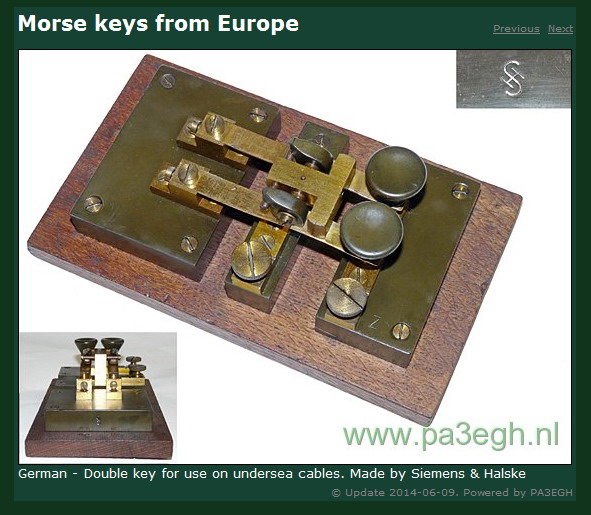
http://www.wj1b.com/western-union-keys.html
Printscreen from this URL

http://w1tp.com/im3000a.htm a lot of Cable Keys
1010 * K1BH's TRANSATLANTIC CABLE KEY:(32KB) Small double (plated) lever key with ivory knobs on Gutta-Perchia base stamped: Edouard BOUTY. Constructeur. Traded to K1BH, 1995.
Below a printscreen form this URL
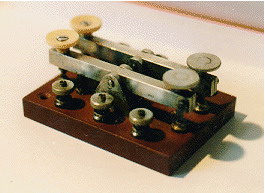
More old keys at:
Cable theory at:
https://en.wikipedia.org/wiki/Cable_theory
History of the Atlantic Cable & Undersea
Communications
http://atlantic-cable.com//
The first atlantic cable 1850 and further
http://atlantic-cable.com/Cables/1921KeyWestHavana/aiee.htm
73, Editor
73, from the town at the rivers "De Bergsche Maas" and "De Dongen" Geertruidenberg (800+ years city rights) at: 51.702211N 4.853854E
Your Editor Jan Pieter Oelp PA3CLQ
-30-
My simple website about Gigantic DF-Antennas
Part 1 "DF-Antenna Wullenweber Array"
Part 2 "DF-Antenna USSR Variants"
Part 3 "DF-Antenna USA Variant"
Next Part 4 "USSR OTHRA DUGA 1,2 & 3" at: